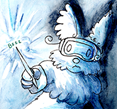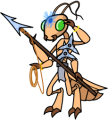Results 1 to 14 of 14
-
2015-04-18, 11:52 PM (ISO 8601)Firbolg in the Playground


- Join Date
- Sep 2009
- Location
- Denver.
- Gender

 How do non mammals aqquire symbiotic organisms?
How do non mammals aqquire symbiotic organisms?
I know that in mammals we get most of our internal ecosystem from our mother, either directly through the placenta / umbilical cord or later through her milk, but how non mammals acquire them? Like I was reading an article the other day about how herbivorous dinosaurs would have needed massive amounts of microbes in their guts to digest that much plant matter, but it didn't say how they got in their or what mechanisms ensured that each animal had the right organisms inside of it. Do they just cling to the animals food sources or what?
Looking for feedback on Heart of Darkness, a character driven RPG of Gothic fantasy.
-
2015-04-18, 11:59 PM (ISO 8601)Ogre in the Playground


- Join Date
- Feb 2005
- Location
- Santa Barbara, CA
- Gender

 Re: How do non mammals aqquire symbiotic organisms?
Re: How do non mammals aqquire symbiotic organisms?
For exhibit A: may I direct your attention to our friends the birds. You may notice that most avian parents regurgitate food for young that are still in the nest. As significant evidence exists for at least some dinosaurs caring for their young this would probably be a significant factor. This behavior is also reasonably common in carnivoria as well.
In reptiles, birds, and presumably dinosaurs encasing some bacteria flora inside an egg may be a major source. Bacteria do get into eggs just fine and as the living animals on the list have cloacas the transfer wouldn't involve the bacteria crossing many barriers. Just have to get there before the outside shell is laid down.
-
2015-04-19, 05:50 AM (ISO 8601)Titan in the Playground


- Join Date
- Apr 2009
- Location
- Germany
 Re: How do non mammals aqquire symbiotic organisms?
Re: How do non mammals aqquire symbiotic organisms?
Humans (and all animals, and I believe even plants) are symbiotic with mitochondria, which are organisms completely separate from themselves. They are like bacteria that live within animal and plant cells. Since they already are in the reproductive cells, they get passed along to any offspring together with their species own DNA.
There are also sea snail that use chlorophyl. Since chlorophyl is not in the snails reproductive cells, young snails don't have any when they hatch and only gain it by eating algae. Some of the chlorophyl will not be digested and instead be transfered to cells in its skin.
There is however one kind of snail that seems to have added some parts of plant DNA to its own and can now produce chlorophyl by itself.Last edited by Yora; 2015-04-19 at 05:54 AM.
We are not standing on the shoulders of giants, but on very tall tower of other dwarves.
Spriggan's Den Heroic Fantasy Roleplaying
-
2015-04-19, 07:05 AM (ISO 8601)Titan in the Playground

- Join Date
- May 2007
- Location
- The Land of Cleves
- Gender

 Re: How do non mammals aqquire symbiotic organisms?
Re: How do non mammals aqquire symbiotic organisms?
Fascinating. I'd never heard of these sea slugs before, so I went looking for a cite: They're called Elysia chlorotica. It appears, though, that the statement that some can produce their own chlorophyll is incorrect: They do have some genetic material incorporated from algae, which presumably facilitates their use of ingested chloroplasts (the organelles which contain the chlorophyll in plants and algae) in a manner which is not fully understood, but the novel genetic material does not directly produce chlorophyll.
Time travels in divers paces with divers persons.
—As You Like It, III:ii:328
Chronos's Unalliterative Skillmonkey Guide
Current Homebrew: 5th edition psionics
-
2015-04-19, 08:28 AM (ISO 8601)Ogre in the Playground

- Join Date
- Aug 2012
- Gender

-
2015-04-19, 09:14 AM (ISO 8601)Orc in the Playground

- Join Date
- May 2013
 Re: How do non mammals aqquire symbiotic organisms?
Re: How do non mammals aqquire symbiotic organisms?
Newborns have no gut flora, and acquire it because people symbiotic bacteria are very resilient and survive in the environment long enough to be transfered between people. Their gut flora is made out of skin bacteria after a few hours, and it only takes a few days for fecal bacteria to take over. It takes year to reach their final balance though, because the baby's diet and digestive function is changing as it grows and the conditions don't favour the same species through time.
Last edited by Dodom; 2015-04-19 at 09:14 AM.
-
2015-04-19, 09:32 AM (ISO 8601)Ogre in the Playground


- Join Date
- Feb 2005
- Location
- Santa Barbara, CA
- Gender

-
2015-04-19, 10:51 AM (ISO 8601)Ogre in the Playground

- Join Date
- Aug 2012
- Gender

 Re: How do non mammals aqquire symbiotic organisms?
Re: How do non mammals aqquire symbiotic organisms?
Ah, but AIUI for elephants it's from eating a lot of not easily digested material and their feces still containing plant material. I don't know how efficient the large herbivorous dinosaurs' digestion was, but seems to me they couldn't pick and choose just the fruits and shoots to eat either to get enough food, possibly leading to undigested material left over as well.
-
2015-04-19, 06:19 PM (ISO 8601)Ogre in the Playground


- Join Date
- Feb 2009
- Gender

 Re: How do non mammals aqquire symbiotic organisms?
Re: How do non mammals aqquire symbiotic organisms?
Yeah, elephant poo is still mostly still whatever plants were eaten, so still quite nutritious and also easier to digest than eating plants directly, all things that a young elephant would benefit from. (think of it as like a cow chewing its cud)
Flora is also obtained from where you are and what you eat.
So all of the factors mentioned+environment and food, all of these things will populate an animals insides and outside with all sorts of microorganisms. It's not like lizards or birds are brushing the dirt and slime off of what they eat, running their air and water through purifiers, and bleaching ever surface they come in contact with after all.Last edited by cobaltstarfire; 2015-04-19 at 06:19 PM.
-
2015-04-19, 08:27 PM (ISO 8601)Pixie in the Playground

- Join Date
- Jun 2014
 Re: How do non mammals aqquire symbiotic organisms?
Re: How do non mammals aqquire symbiotic organisms?
This world is dominated by microscopic organisms. You breathe them in and out and eat the ones that land in your food. Bacterial and fungal spores are so tenacious that they can infiltrate your bread box and your refrigerator and live off of what's inside. The same thing happens to your body, except your immune system protects you from the stuff trying to harm you while other things get under the radar by living commensally on and within you.
Random fun facts from microbiology class (that i can remember): roughly 10% of your body weight is bacteria. Some of the bacteria that has adapted to live on your skin (high UV and salt concentrations, arid conditions) actually help fight infections in a way by competing with other bacteria that might harm you if they entered through a cut or something. There is a difference in the number and type of bacterial species that live on your left and right hands.
And an example of a non-mammal with an endosymbiont is any bug that subsists solely off of plant sap like aphids. Sap is a high hydrocarbon energy source, but it lacks in amino acids to build proteins, so bugs of this variety have endosymbionts that can make them somehow (i forget). Also, some plants have relations with fungi, which they allow to invade their root cells and exchange carbohydrates for inorganic ions.
-
2015-04-21, 10:31 AM (ISO 8601)Titan in the Playground


- Join Date
- Aug 2008
 Re: How do non mammals aqquire symbiotic organisms?
I would really like to see a game made by Obryn, Kurald Galain, and Knaight from these forums.
Re: How do non mammals aqquire symbiotic organisms?
I would really like to see a game made by Obryn, Kurald Galain, and Knaight from these forums.
I'm not joking one bit. I would buy the hell out of that. -- ChubbyRain
Current Design Project: Legacy, a game of masters and apprentices for two players and a GM.
-
2015-04-21, 11:23 AM (ISO 8601)Pixie in the Playground

- Join Date
- Jun 2014
 Re: How do non mammals aqquire symbiotic organisms?
Re: How do non mammals aqquire symbiotic organisms?
you're right. i googled a bit to see if the 10% figure was floating around anywhere, but what I came back with was 90% by cell count (including everything that lives on your skin and in your gut) and only 1% by mass.
-
2015-04-21, 11:37 AM (ISO 8601)Titan in the Playground


- Join Date
- Nov 2007
- Location
- Cippa's River Meadow
- Gender

 Re: How do non mammals aqquire symbiotic organisms?
Re: How do non mammals aqquire symbiotic organisms?
While researching for another thread, I founds some animals which incorporate other organisms by a variety of methods: link.
The sea slug ingests plant material and a special pouch engulfs chloroplasts whole then incorporates them into their own cells. The spotted salamander develops a symbiotic relationship with algae during their foetal stage: link.
-
2015-04-21, 03:28 PM (ISO 8601)Ettin in the Playground


- Join Date
- Aug 2011
- Location
- Sharangar's Revenge
- Gender

 Re: How do non mammals aqquire symbiotic organisms?
Warhammer 40,000 Campaign Skirmish Game: Warpstrike
Re: How do non mammals aqquire symbiotic organisms?
Warhammer 40,000 Campaign Skirmish Game: Warpstrike
My Spelljammer stuff (including an orbit tracker), 2E AD&D spreadsheet, and Vault of the Drow maps are available in my Dropbox. Feel free to use or not use it as you see fit!
Thri-Kreen Ranger/Psionicist by me, based off of Rich's A Monster for Every Season




 Reply With Quote
Reply With Quote






 RSS Feeds:
RSS Feeds: 

